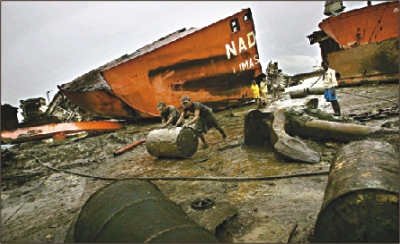Ship-breaking in Ctg
Sea polluted under authorities' nose
Morshed Ali Khan, back from Ctg
Despite the involvement of several government departments in the process of scrapping ships, the Sitakunda ship-breaking yards in Chittagong continue to operate in the most rudimentary way polluting the coastal environment, violating workers' rights, and putting their security at risk.Experts said 40-square-kilometres of the Bay of Bengal, along the Dhaka-Chittagong highway is under severe threat of an ecological disaster. Every year around 150 ocean-going ships, weighing between 10,000 tons and 550,000 tons each, are scrapped on the beaches of Sitakunda with bare hands, extracting up to 1.8 million tons of scrap metal annually in addition to various other items found in the ships. In the process, lethal pollutants are regularly released in the water, land and air. The history of Sitakunda ship breaking dates back to 1965 when an ocean-going ship weighing 20,000 tons was driven ashore near Fouzdarhat by a devastating tidal bore. Unable to move the ship, the local people started to dismantle it. In the mid eighties, the trade reached its peak with nearly 70 entrepreneurs. Currently, the most influential '13 players' under the Bangladesh Ship Breakers Association (BSBA) control the 20 ship-breaking yards. According to officials, Sitakunda is the largest ship-breaking place in the world, followed by India and China. Considering the sector's environmental hazards, China is slowly winding up its ship-breaking activities. In many countries when a ship is 'written off' after its life of 25 years, it goes through intensive cleaning and detoxification process and then sunk in the deep sea to create sanctuaries for marine life. In Sitakunda, lack of regard for the environment and safety of the workers is exposing thousands to health hazards. More alarming, there is an unofficial embargo imposed by the influential owners' syndicate on all information related to pollution and accidents in the 20 ship-breaking yards in which unconfirmed number of people suffer or die every year. The hazards are on the rise. All ships arriving for scrapping must be washed thoroughly for detoxification, according to maritime law. But most obsolete ships arriving in Chittagong are laden with highly toxic substances and gases. The sellers of obsolete ships take full advantage of the country's sloppy monitoring mechanism and never bother to clean or detoxify the vessels. According to sources, it is very common to find the vessel laden with asbestos, oil sludge, lead, cadmium, arsenic, biocides and even traces of radioactive substances. The leaders of the BSBA blame the government for failing to recognise the largest ship-breaking spot in the world as an industry. They said despite repeated appeals, the government has mysteriously remained silent over providing any support for the 'industry'. The President of BSBA, Zafar Alam said it is not true that ship breakers are polluting the coastal line. "There are other industries in Chittagong which are polluting the land, air and sea much more than the ship-breaking yards, why don't you talk about them?" he demanded. But the massive activities surrounding the ship-breaking in Chittagong do not go without monitoring and inspections by a wide range of government officials. In papers, almost all ships are legally beached and scrapped. But sources in the trade confirmed that the ship-breakers are able to bring 'any ship' they want, regardless of its toxicity or danger and they get all papers ready in no time. For instance, recently a highly toxic ship laden with asbestos, Alpha Ship, got all clearance for scrapping at a Sitakunda yard. When the matter was reported in the media, the owners were forced by the government to send the ship back to its seller. In the process of clearing an obsolete ship for beaching and scrapping, the owners have to obtain clearance certificates from inspectors of the Department of Explosives. The investigators are supposed to check the vessel if it contained any toxic material. Four separate groups from the Department of Customs have to certify on general assessment, boarding, ravaging and intelligence. The Chittagong Port Authority (CPA) has to issue a port clearance. Finally the Bangladesh Navy has to inspect the vessel and confiscate all communication devices, including radar, walkie-talkies, distress signal equipments and high frequency wireless sets. According to sources close to the trade, the owners go into package deals with the Department of Explosives, paying around Tk 5,000 for each certificate. Although four separate teams from the Department of Customs are supposed to visit the vessel, only the ravaging team visits the ship under a deal of Tk 25,000 for each clearance certificate. The sensitive communication devices, which are supposed to be confiscated by the Bangladesh Navy, end up at scrap shops along the Dhaka Chittagong highway in Sitakunda. Posing as a buyer from Dhaka, this correspondent asked two separate scrap dealers if they could supply five high frequency wireless sets, ten pairs of walkie-talkies and five radars. The condition was that all equipments should be functional. Both of them readily agreed to sell, instantly providing manuals for the wireless and radar. They said they would need two to three days to ensure supply of all the equipments. "I can supply the walkie-talkies, two wireless sets and a radar now but for the remaining items you have to come back in two days," said a young trader. According to sources, huge quantities of steel and non-ferrous items, such as bronze, aluminium copper, bronze-amalgam, retrieved from the ships are regularly smuggled out of the country through the Feni border. Although the ship breaking trade is contributing to the country's economy by providing annual revenues of over Tk 800 crore, and meeting about 80 per cent of the country's demand for steel, helping at least 20 other industries to develop, government's indifference to address its problem may make the sector murkier.
|

Workers pushing a barrel at the ship-breaking yard on Sitakunda beach, often littered with hazardous chemicals. Photo: Q Sakamaki |